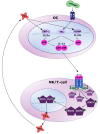Immunology of IL-12: An update on functional activities and implications for disease
- PMID: 33408595
- PMCID: PMC7783470
- DOI: 10.17179/excli2020-3104
Immunology of IL-12: An update on functional activities and implications for disease
Abstract
As its first identified member, Interleukin-12 (IL-12) named a whole family of cytokines. In response to pathogens, the heterodimeric protein, consisting of the two subunits p35 and p40, is secreted by phagocytic cells. Binding of IL-12 to the IL-12 receptor (IL-12R) on T and natural killer (NK) cells leads to signaling via signal transducer and activator of transcription 4 (STAT4) and subsequent interferon gamma (IFN-γ) production and secretion. Signaling downstream of IFN-γ includes activation of T-box transcription factor TBX21 (Tbet) and induces pro-inflammatory functions of T helper 1 (TH1) cells, thereby linking innate and adaptive immune responses. Initial views on the role of IL-12 and clinical efforts to translate them into therapeutic approaches had to be re-interpreted following the discovery of other members of the IL-12 family, such as IL-23, sharing a subunit with IL-12. However, the importance of IL-12 with regard to immune processes in the context of infection and (auto-) inflammation is still beyond doubt. In this review, we will provide an update on functional activities of IL-12 and their implications for disease. We will begin with a summary on structure and function of the cytokine itself as well as its receptor and outline the signal transduction and the transcriptional regulation of IL-12 secretion. In the second part of the review, we will depict the involvement of IL-12 in immune-mediated diseases and relevant experimental disease models, while also providing an outlook on potential translational approaches.
Keywords: IL-12; STAT4; TH1 cells; cytokines; immunology; ustekinumab.
Copyright © 2020 Ullrich et al.
Figures



Similar articles
-
Interleukin-12: Functional activities and implications for disease.Cytokine Growth Factor Rev. 2015 Oct;26(5):559-68. doi: 10.1016/j.cytogfr.2015.07.003. Epub 2015 Jul 4. Cytokine Growth Factor Rev. 2015. PMID: 26182974 Review.
-
CD8 T cells in innate immune responses: using STAT4-dependent but antigen-independent pathways to gamma interferon during viral infection.mBio. 2014 Oct 21;5(5):e01978-14. doi: 10.1128/mBio.01978-14. mBio. 2014. PMID: 25336459 Free PMC article.
-
Expanding Diversity in Molecular Structures and Functions of the IL-6/IL-12 Heterodimeric Cytokine Family.Front Immunol. 2016 Nov 4;7:479. doi: 10.3389/fimmu.2016.00479. eCollection 2016. Front Immunol. 2016. PMID: 27867385 Free PMC article. Review.
-
Signaling by IL-12 and IL-23 and the immunoregulatory roles of STAT4.Immunol Rev. 2004 Dec;202:139-56. doi: 10.1111/j.0105-2896.2004.00211.x. Immunol Rev. 2004. PMID: 15546391 Review.
-
Interferon-gamma: biologic functions and HCV therapy (type I/II) (1 of 2 parts).Clin Ter. 2006 Jul-Aug;157(4):377-86. Clin Ter. 2006. Retraction in: Clin Ter. 2008 May-Jun;159(3):207. PMID: 17051976 Retracted. Review.
Cited by
-
Influenza B Virus (IBV) Immune-Mediated Disease in C57BL/6 Mice.Vaccines (Basel). 2022 Sep 1;10(9):1440. doi: 10.3390/vaccines10091440. Vaccines (Basel). 2022. PMID: 36146518 Free PMC article.
-
The Genetic Landscape of Systemic Rheumatic Diseases: A Comprehensive Multigene-Panel Study Identifying Key Gene Polymorphisms.Pharmaceuticals (Basel). 2024 Mar 28;17(4):438. doi: 10.3390/ph17040438. Pharmaceuticals (Basel). 2024. PMID: 38675400 Free PMC article.
-
Potential of Neuroinflammation-Modulating Strategies in Tuberculous Meningitis: Targeting Microglia.Aging Dis. 2024 May 7;15(3):1255-1276. doi: 10.14336/AD.2023.0311. Aging Dis. 2024. PMID: 37196131 Free PMC article. Review.
-
Diet-induced obesity affects influenza disease severity and transmission dynamics in ferrets.Sci Adv. 2024 May 10;10(19):eadk9137. doi: 10.1126/sciadv.adk9137. Epub 2024 May 10. Sci Adv. 2024. PMID: 38728395 Free PMC article.
-
Update on the pathophysiology and treatment of primary Sjögren syndrome.Nat Rev Rheumatol. 2024 Aug;20(8):473-491. doi: 10.1038/s41584-024-01135-3. Epub 2024 Jul 9. Nat Rev Rheumatol. 2024. PMID: 38982205 Review.
References
-
- Adedokun OJ, Xu Z, Gasink C, Jacobstein D, Szapary P, Johanns J, et al. Pharmacokinetics and exposure response relationships of ustekinumab in patients with Crohn's disease. Gastroenterology. 2018;154:1660–1671. - PubMed
-
- Aghaei Meybodi HR, Hasanzad M, Larijani B. Path to personalized medicine for type 2 diabetes mellitus: Reality and hope. Acta Med Iran. 2017;55:166–174. - PubMed
Publication types
LinkOut - more resources
Full Text Sources
Other Literature Sources
Research Materials
Miscellaneous
